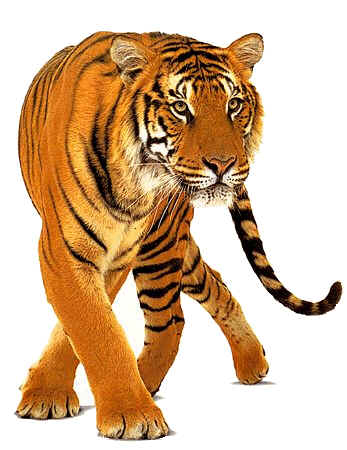 |
 |
 |
|
~ Tiger - Nature and Wild Life Info Highway (Wikipedia)~
|
|
| Sumatran Tiger |

|
Hello, everybody. The mission of making this site is to send a message to the people to preserve plants, animals and natural
communities that represent the diversity of life on Earth by protecting the lands and waters they need to survive. As Tiger
is my favorite animal, I have mentioned Tiger first.
From thick forests and bamboo jungles to mangrove swamps and snowy regions, tigers are found in several different habitats.
In India, tigers are found in grasslands, dry forests, mangroves and evergreen hills. The largest and most powerful member
of the cat family, the tiger is the king of the Indian jungle. But sadly, tigers are extremely endangered, with only about
3000 of these gorgeous animals left in the wild today. In the name of development, the tiger's forest home is being destroyed
and they are being hunted for their skin and bones.
If we have to save the tiger, we have to save the forest. If the forest survives, we will save thousands of other forest
creatures, and we will save ourselves. That because if we save the forests, the forests will save our water. Ancient Indians
in their local language used to say, "Jungle Nadi ki maa hai" or "the forest is the mother of the river".
They knew then that although it rained only for four months, it was the forest that helped the rivers to flow for 12 months.
|
 |
|
Welcome!! to the information highway on WILDLIFE, if you do not find it here you won't find it anywhere. I have decided to
dedicate my website to one of my passions; and that is saving the animals of this planet!! I believe that knowledge is power!!
If we don't know about something, then we can't do anything about it, but once we DO know, then it is our responsibility to
do something about it!! My primary goal is to educate us all about the problems that our wildlife encounters, and hopefully,
together we CAN do something positive about it!! I believe that each individual on this planet CAN make a difference in this
life, and I hope throughout this site, together WE can make a difference.
When experts say that the population of tigers in the wild is small, it isn't an exaggeration. There are less than four
thousand specimens, and some subspecies are already extinct in the wild. These numbers make it hard to achieve reproduction
rates appropriate to increase the population. Protection against inbreeding also needs to take place so that they keep the
genetic diversity.
Artic region.
I would like to say about the arctic region first as I am much impressed by the arctic animals. The world has many different
animals. In the Arctic, we have many animals that are unique to the north that we would like to tell you about. I have chosen
some of the most unique arctic animals there are. I have stories to read, great pictures of the animals, interesting facts
to share, and some fun activities to do. The Arctic is an exciting place full of animals and people. There are many types
of animals that have their own habitat and it isn't all frozen. The animals vary in size and characteristics.
The Arctic has eight nations within it. They are Canada, Denmark (Greenland), Finland, Iceland, Norway, Russia, Sweden
and the United States. It is an area with 2 million people in it and over 50 languages. One reason that it is a very important
area is because of how it affects the weather patterns in the northern hemisphere.
The arctic land is mainly tundra. This frozen ground is above the tree line and is covered with hearty plants like moss
and lichen, which caribou and muskox feed on. The arctic animals are hearty creatures because low temperatures and precipitation
with strong winds are not uncommon in the Arctic.
The different animals we've listed here live all over the Arctic. Most do not go below the arctic circle or 66-1/2 degrees
north latitude. Each of them is vital and significant to each other and to the arctic people for survival.
The people of arctic Alaska depend on the caribou and muskox for most of their food and clothing. Some villages in Greenland
and arctic Canada depend on the narwhal for their entire existence!
A wide range of marine mammals and fish live in the severe conditions of the Arctic ocean. Whales, dolphins (narwhal),
walruses and seals all make their home in this North Polar region which is covered by ice most of the year. The great polar
bear depends on these marine mammals and fish for its survival.
|
 |

|
 |
|

|
 |
|
|





